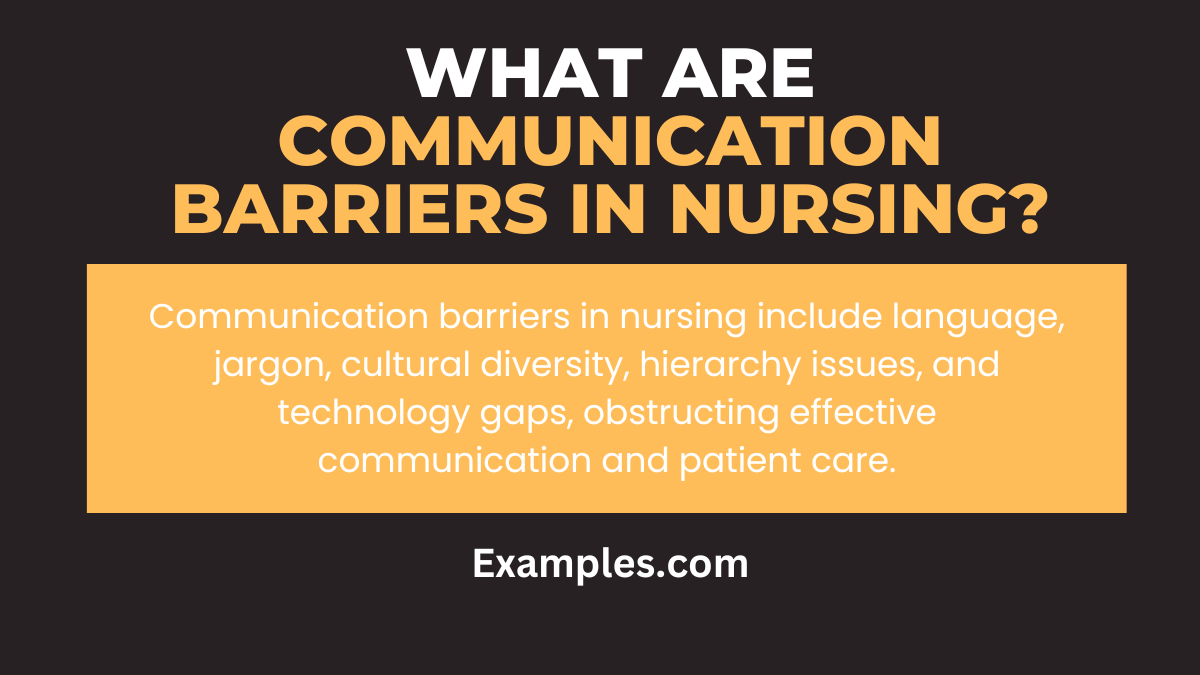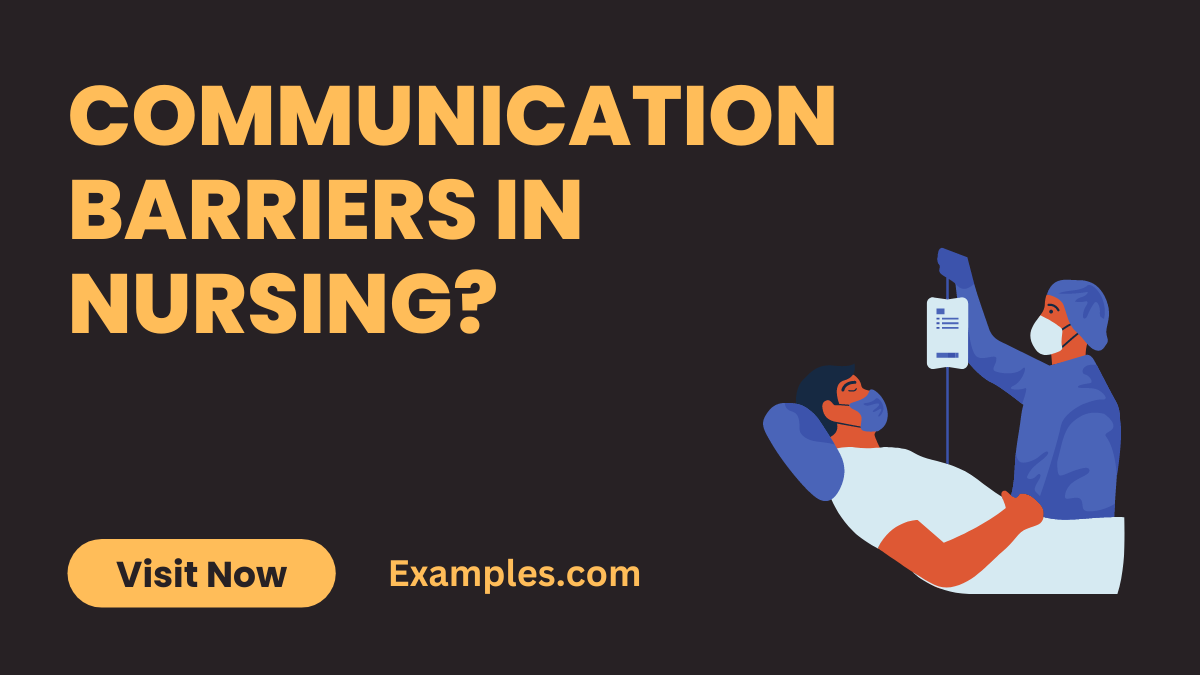29+ Communication Barriers in Nursing Examples
Embark on a transformation journey through our comprehensive guide on “Communication Barriers in Nursing.” Uncover the intricacies that hinder effective communication in healthcare settings and explore practical solutions. With insightful “Communication Examples,” we navigate the challenges nurses face daily. This guide equips you to foster clearer team connections, ensuring optimal patient care. Elevate your nursing practice by mastering communication skills essential for delivering exceptional healthcare outcomes.
What are Communication Barriers in Nursing?

Communication barriers in nursing refer to obstacles that impede the effective exchange of information among healthcare professionals, patients, and other stakeholders in the healthcare setting. These barriers can arise from various sources, hindering the seamless flow of communication and potentially compromising patient care. Common communication barriers in nursing include language differences, hierarchical structures, inadequate training, distractions, and technological challenges. Overcoming these barriers is crucial to ensuring accurate information exchange, promoting patient safety, and fostering collaborative and patient-centered care in healthcare settings.
What is the Best Example of Communication Barriers in Nursing?

One of the best examples of communication barriers in nursing is when a patient’s medical history and critical information are inaccurately transferred during a shift change or handoff between nursing teams. Inadequate or unclear communication during this transition can lead to misunderstandings, missed details, and potential patient safety risks. This scenario underscores the importance of effective handoff communication protocols to ensure seamless and accurate information exchange in nursing practice.
30 Top Communication Barriers in Nursing

Discover the nuances of communication challenges in nursing through our guide. From language disparities to technological hurdles, explore insights and strategies to overcome these barriers and foster a seamless healthcare environment.
- Language Differences
- Challenge: Diverse language proficiencies hinder understanding.
- Solution: Implement language training and utilize translation tools for clear communication.
- Hierarchy Struggles
- Challenge: Hierarchical structures hinder open dialogue.
- Solution: Foster a culture of open communication, encouraging input from all levels.
- Technological Overload
- Challenge: Overreliance on technology leads to information overload.
- Solution: Balance digital tools with face-to-face interactions, and provide tech training.
- Distractions in Healthcare
- Challenge: External interruptions impede focus.
- Solution: Designate quiet zones and implement focus-friendly policies.
- Inadequate Training
- Challenge: Lack of communication training hampers efficiency.
- Solution: Provide comprehensive communication skills training programs.
- Cultural and Ethnic Disparities
- Challenge: Varied cultural norms impact interpretation.
- Solution: Facilitate cultural competency training to enhance understanding.
- Insufficient Feedback
- Challenge: A dearth of constructive feedback stunts growth.
- Solution: Establish regular feedback sessions and open communication channels.
- Information Overload
- Challenge: Excessive data hampers comprehension.
- Solution: Prioritize essential information and streamline communication channels.
- Resistance to Change
- Challenge: Resistance impedes the adoption of new communication methods.
- Solution: Provide training, communicate benefits, and involve staff in the process.
- Limited Face-to-Face Interaction
- Challenge: Overreliance on digital communication excludes personal touch.
- Solution: Schedule periodic face-to-face meetings to foster connections.
- Ambiguous Roles
- Challenge: Unclear responsibilities lead to confusion.
- Solution: Clearly define roles and responsibilities for each nursing team member.
- Overemphasis on Documentation
- Challenge: Excessive documentation can detract from real-time communication.
- Solution: Implement efficient documentation practices, focusing on essential information.
- Mismatched Communication Styles
- Challenge: Varied communication preferences lead to confusion.
- Solution: Conduct assessments and provide communication style guides.
- Shift Changes
- Challenge: Communication breakdowns often occur during shift transitions.
- Solution: Implement standardized handover protocols and use technology for continuity.
- Inconsistent Policies
- Challenge: Unclear or changing policies create confusion.
- Solution: Regularly update and communicate policies transparently.
- Inadequate Use of Communication Tools
- Challenge: Underutilization of tools hampers efficient communication.
- Solution: Provide training on communication tools and their effective use.
- Lack of Emotional Support
- Challenge: Emotional needs may be overlooked in communication.
- Solution: Incorporate empathy training for better emotional support.
- Time Constraints
- Challenge: Limited time impacts the depth of communication.
- Solution: Prioritize essential discussions and utilize efficient communication methods.
- Fear of Speaking Up
- Challenge: Nurses hesitate to voice concerns.
- Solution: Foster a culture that values diverse opinions and encourages feedback.
- Patient Health Literacy
- Challenge: Communicating complex medical information to patients.
- Solution: Provide patient education materials in accessible formats and ensure comprehension.
- Interruptions during Patient Care
- Challenge: Frequent interruptions disrupt focused communication.
- Solution: Implement communication-friendly protocols during critical patient care moments.
- High-Stress Environments
- Challenge: Stress impacts communication effectiveness.
- Solution: Provide stress management training and promote wellness programs.
- Reluctance to Seek Clarification
- Challenge: Fear of judgment hinders seeking clarification.
- Solution: Promote a culture that values questions and encourages seeking clarity.
- Overuse of Medical Jargon
- Challenge: Technical language can be confusing for patients.
- Solution: Use plain language and provide patient-friendly explanations.
- Patient Privacy Concerns
- Challenge: Balancing communication with patient privacy regulations.
- Solution: Train staff on privacy laws and communicate sensitively within legal bounds.
- Inadequate Handoff Communication
- Challenge: Incomplete handoffs lead to missed information.
- Solution: Standardize handoff procedures and emphasize critical information transfer.
- Ineffective Team Meetings
- Challenge: Meetings may lack structure and effectiveness.
- Solution: Establish clear agendas, encourage participation, and follow up on action items.
- Lack of Interdisciplinary Communication
- Challenge: Silos hinder communication between different healthcare disciplines.
- Solution: Promote interdisciplinary meetings and collaboration.
- Limited Access to Communication Resources
- Challenge: Insufficient access to communication tools.
- Solution: Ensure all staff have access to necessary communication resources.
- Patient-Provider Mismatch
- Challenge: Differences in communication styles between patients and providers.
- Solution: Implement training for providers to adapt communication styles based on patient needs.
What are the Barriers of Effective Communication in Nursing?
Dive into the complexities of effective communication challenges within the nursing domain, exploring the myriad barriers that impact patient care. From hierarchical structures to language disparities, this guide delves deep into each impediment with practical examples. Uncover strategies to overcome these barriers, fostering a communication-rich environment that enhances collaboration and elevates the standard of nursing care. Whether you’re a nursing professional or a healthcare leader, this guide offers valuable insights for dismantling communication obstacles in the intricate world of nursing.
How to Overcome Communication Barriers in Nursing?
Overcoming communication barriers in nursing requires a concerted effort from healthcare professionals and organizations. Here are some key strategies:
- Effective Training: Provide nurses with communication skills training, including active listening, empathy, and clear articulation.
- Use of Standardized Tools: Implement standardized handoff tools and protocols to ensure consistent and clear communication during patient transfers and shifts.
- Interdisciplinary Collaboration: Encourage interdisciplinary collaboration, where nurses, physicians, and other healthcare team members communicate openly and regularly to ensure comprehensive patient care.
- Technology Integration: Utilize technology, such as electronic health records and secure messaging systems, to facilitate seamless communication and information sharing.
- Cultural Competency: Promote cultural competency among nurses to navigate language and cultural differences effectively.
- Feedback Mechanisms: Establish feedback mechanisms where nurses can provide input on communication processes and suggest improvements.
What are the Primary Causes of Communication Barriers in Nursing Practice?
Several factors contribute to communication barriers in nursing practice, including:
- Lack of Training: Inadequate training in communication skills and techniques can hinder effective interactions between nurses and patients or among healthcare professionals.
- Time Pressure: The fast-paced nature of healthcare settings can lead to rushed communication, resulting in misunderstandings or incomplete information exchange.
- Hierarchical Structure: Hierarchies within healthcare organizations can deter open communication, particularly between nurses and physicians.
- Language and Cultural Differences: Patients and healthcare providers may have diverse cultural backgrounds and languages, making communication challenging.
- Technology Challenges: Overreliance on technology or issues with electronic systems can disrupt communication flow.
- Stress and Emotions: High-stress environments, such as emergency rooms or intensive care units, can affect communication clarity and effectiveness.
How do Communication Barriers Impact Patient Care in Nursing?
Communication barriers in nursing practice can have significant negative impacts on patient care:
- Misunderstandings: Patients may not fully understand their diagnoses or treatment plans, leading to noncompliance or missed care instructions.
- Medication Errors: Miscommunication can result in medication errors, where patients receive the wrong medications or incorrect dosages.
- Delayed Care: Incomplete or unclear communication can lead to delays in delivering necessary care, potentially worsening patient conditions.
- Patient Safety: Communication barriers can compromise patient safety, as healthcare providers may miss critical information about allergies, medical history, or changes in vital signs.
- Increased Stress: Patients and their families may experience increased stress and anxiety when they perceive poor communication, affecting their overall healthcare experience.
In conclusion, recognizing, addressing, and mitigating communication barriers in nursing is vital. Examples include inadequate handoffs, language barriers, and hierarchical structures. These barriers adversely affect patient care through misunderstandings, errors, and delays. Signs of such barriers include confusion and frustration. To remedy this, nurses should undergo communication skills training, employ standardized tools, and foster interdisciplinary collaboration, ensuring that patients receive the safe and effective care they deserve.



